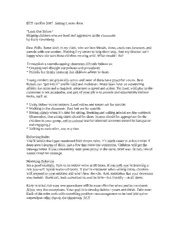
ERIC EJ754258: "Look Out Below": Helping Children Who Are Loud and Aggressive in the Classroom PDF
Preview ERIC EJ754258: "Look Out Below": Helping Children Who Are Loud and Aggressive in the Classroom
ECT Jan/Feb 2007 Setting Limits -Free “Look Out Below” Helping children who are loud and aggressive in the classroom by Polly Greenberg Dear Polly, Some boys in my class, who are best friends, shout, crash into furniture, and wrestle with one another. Nothing I try seems to help them stop. And my director isn’t happy when she sees these children running wild. What should I do? To establish a smooth-running classroom, I firmly believe in: * Creating well-thought out policies and procedures * Politely but firmly insisting that children adhere to them. Young children are physically active and most of them have powerful voices. Best friends can “get into it” and be loud and exuberant. Many boys have an astonishing affinity for noise and a magnetic attraction to speed and action. Yet loud, wild play in the classroom is not acceptable, and part of your job is to provide and consistently enforce limits, such as: * Using indoor voices indoors. Loud voices and noises are for outside. * Walking in the classroom. Fast feet are for outside. * Sitting calmly when it’s time for sitting. Running and rolling around are fine outdoors. (Remember, that sitting times should be short. Stories should be appropriate for the children in your group, and occasional teacher-directed activities should be fast-paced and engaging.) * Talking to each other, one at a time. Enforcing Rules You’ll notice that I just mentioned four simple rules. It’s much easier to enforce rules if there aren’t dozens of them, just a few that cover the waterfront. Children will get the message better if you consistently state your policy in the same, brief way. In fact, lots of words cloud the message. Modeling Behavior Set a good example. Talk in an indoor voice at all times. If you yell, you’re breaking a rule yourself. Speak matter-of-factly. If you’re emotional when setting limits, children will respond to your emotion and won’t hear the rule. And, remember that your demeanor also matters. Stand tall, look authoritative, and be firm—but friendly—at all times. Keep in mind that your new procedures will be most effective when you’re consistent. Allow very few exceptions. Your goal is to develop habits—yours and theirs. Take note: Each of the rules ends with something positive—encouragement to be loud and active somewhere other than in the classroom. ECT Polly Greenberg has been a child/parent/ staff development specialist for almost 50 years. She has worked for the U.S. Department of Education, the Department of Health and Human Services, the War on Poverty, and the NAEYC.
